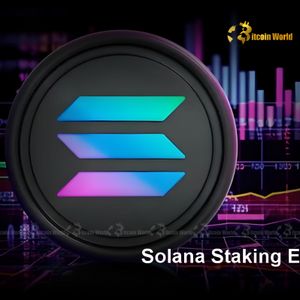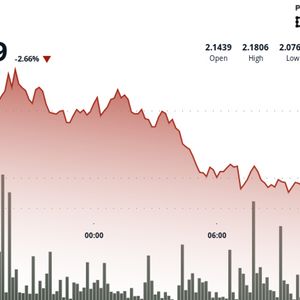Solana Staking ETF: A Breakthrough Opportunity for Investors
8 min read
BitcoinWorld Solana Staking ETF: A Breakthrough Opportunity for Investors The cryptocurrency world is abuzz with anticipation! A significant development could be on the horizon, potentially reshaping how traditional investors access digital assets. Imagine gaining exposure to a leading blockchain like Solana, not just for its price appreciation, but also for the passive income it can generate through staking. This week, the whispers have grown louder, suggesting that a Solana Staking ETF might just be on the cusp of approval. This groundbreaking financial product promises to bridge the gap between conventional finance and the dynamic world of decentralized networks, offering a unique blend of growth potential and yield generation. What is a Solana Staking ETF, and Why Does it Matter? At its core, a Solana Staking ETF is an exchange-traded fund designed to hold Solana (SOL) tokens and, crucially, stake them to earn rewards. For those new to the concept, an ETF is a type of investment fund that trades on stock exchanges, much like a regular stock. It typically holds assets like stocks, bonds, or commodities. In the crypto realm, ETFs allow investors to gain exposure to digital currencies without directly buying, storing, or managing them. The ‘staking’ component is what makes this particular ETF so exciting. Staking involves locking up cryptocurrency to support the operations of a proof-of-stake (PoS) blockchain network, like Solana. In return for contributing to the network’s security and validation process, stakers receive rewards, often in the form of newly minted tokens. The REX-Osprey SOL + Staking ETF, specifically mentioned by Bloomberg analyst James Seyffart, aims to do exactly this: track Solana’s performance while simultaneously generating yield through its staking activities. This offers a dual benefit for investors: potential capital appreciation from SOL’s price movements and ongoing income from staking rewards. Key aspects of a Staked Solana ETF: Indirect Exposure: Investors gain exposure to Solana without needing a crypto wallet or understanding complex blockchain mechanics. Yield Generation: The ETF’s design allows it to participate in Solana’s staking mechanism, passing on yield to investors. Regulatory Wrapper: Being an ETF, it operates within a regulated framework, potentially appealing to institutional investors and those wary of direct crypto investments. The Path to Solana ETF Approval: Analyst Insights and Regulatory Landscape The anticipation around a Solana ETF Approval has reached a fever pitch, largely thanks to insights from prominent industry analysts. James Seyffart, a well-respected Bloomberg ETF analyst, recently stirred the pot with his suggestion on X (formerly Twitter) that a Solana Staking ETF could indeed see approval this very week. His comments carry weight, given his track record in forecasting the approval of spot Bitcoin and Ethereum ETFs. The journey for any crypto-backed ETF in the United States has been long and fraught with regulatory challenges. The Securities and Exchange Commission (SEC) has historically been cautious, citing concerns about market manipulation, investor protection, and the nascent nature of the crypto markets. However, the recent approvals of spot Bitcoin ETFs and, more recently, spot Ethereum ETFs, have set a precedent. While Bitcoin and Ethereum operate on different consensus mechanisms (Proof-of-Work and Proof-of-Stake, respectively, for Ethereum post-Merge), the SEC’s evolving stance on digital assets is a positive sign. The key differentiator for a Solana Staking ETF lies in the ‘staking’ component, which the SEC has previously viewed with skepticism, often classifying staking services as unregistered securities. The approval of an ETF that actively engages in staking would signal a significant shift in this regulatory perspective, potentially opening doors for a new wave of yield-generating crypto investment products. This move would not only validate Solana as a significant digital asset but also legitimize staking as a permissible activity within regulated financial products. Unlocking Crypto Staking Yield: Benefits for Investors For many investors, the allure of cryptocurrencies extends beyond just price appreciation; it’s also about the potential for passive income. A Crypto Staking Yield mechanism embedded within an ETF offers several compelling benefits: Simplified Access to Yield: Traditionally, earning staking rewards requires technical knowledge to set up a validator node or choose a staking service, manage private keys, and navigate unbonding periods. An ETF removes these complexities, allowing investors to earn yield through their brokerage accounts. Diversification with Income: For traditional portfolios, adding a yield-bearing digital asset can provide a new source of income, diversifying beyond traditional dividends or bond yields. It introduces a high-growth asset class with an additional income stream. Enhanced Returns: Staking rewards can significantly boost the overall return on investment, especially in volatile markets. While the primary driver remains SOL’s price, the consistent yield acts as a buffer and a compounding factor. Liquidity: Unlike direct staking which often involves lock-up periods, an ETF is traded on an exchange, offering daily liquidity. Investors can buy and sell shares throughout the trading day, providing flexibility that direct staking often lacks. Consider the potential for investors seeking exposure to the high-performance Solana network. Instead of merely buying SOL and holding it, an ETF that stakes could provide a more attractive proposition by enhancing returns through the generated yield. This could be particularly appealing to institutional investors and wealth managers looking for compliant ways to offer crypto exposure with added benefits to their clients. Navigating the Challenges: Risks and Considerations for Digital Asset ETFs While the prospect of a Digital Asset ETFs offering staking yield is exciting, it’s crucial for investors to understand the inherent risks and challenges. No investment is without its downsides, and crypto-backed ETFs are no exception. Key risks associated with Solana Staking ETFs: Market Volatility: Solana, like other cryptocurrencies, is subject to extreme price volatility. While staking yield can cushion some impact, a significant downturn in SOL’s price could still lead to substantial losses for investors. Staking Risks: Although the ETF handles the staking process, the underlying risks remain. This includes ‘slashing,’ where a validator’s staked tokens are penalized for misbehavior (e.g., going offline). While ETFs will likely use reputable staking providers, the risk is not entirely eliminated. Unbonding periods, where staked tokens are locked for a set time before they can be withdrawn, could also impact the ETF’s liquidity management. Custody and Security: The security of the underlying SOL tokens held by the ETF’s custodian is paramount. While ETFs typically use institutional-grade custodians, the risk of hacks or security breaches, though low, is always present in the digital asset space. Regulatory Uncertainty: Despite recent approvals, the regulatory landscape for cryptocurrencies, especially those involving staking, remains fluid. Future regulatory changes could impact the ETF’s operations or even its viability. Tracking Error and Fees: ETFs aim to track the performance of their underlying assets, but ‘tracking error’ can occur. Additionally, management fees charged by the ETF provider will eat into returns, potentially offsetting some of the staking yield. Investors must carefully review the expense ratios. It is imperative for potential investors to conduct thorough due diligence and understand these risks before committing capital. While the ETF structure provides a layer of professional management and regulatory oversight, it does not eliminate the inherent risks of investing in a volatile asset class like cryptocurrency. The Dawn of Institutional Crypto Investment: What’s Next? The potential approval of a Solana Staking ETF marks a significant milestone, not just for Solana, but for the entire landscape of Institutional Crypto adoption. It signifies a growing acceptance and maturation of digital assets within traditional financial frameworks. This development could pave the way for a broader array of crypto-backed financial products, moving beyond just Bitcoin and Ethereum. The implications are far-reaching: Increased Mainstream Adoption: Easier access through familiar investment vehicles like ETFs can attract a wider pool of investors, including retail investors who prefer regulated products and institutional funds with strict compliance requirements. Enhanced Liquidity and Market Depth: As more institutional capital flows into Solana through ETFs, it could lead to increased liquidity and greater market depth for the SOL token, potentially reducing volatility over the long term. Validation for Proof-of-Stake: An ETF explicitly incorporating staking would further validate the Proof-of-Stake consensus mechanism in the eyes of regulators and traditional finance, potentially encouraging more innovation in this area. Catalyst for Other Altcoin ETFs: If a Solana Staking ETF proves successful, it could set a precedent for similar products tracking other major altcoins that utilize staking, such as Cardano (ADA), Polkadot (DOT), or Avalanche (AVAX). This would dramatically expand the investment opportunities within the digital asset space for traditional investors. This is not just about a single ETF; it’s about the continued integration of a revolutionary technology into the established financial system. The shift from speculative trading to regulated investment vehicles is a crucial step towards the long-term sustainability and growth of the crypto economy. Actionable Insights: What Should Investors Consider? For investors intrigued by the prospect of a Solana Staking ETF, here are some actionable insights to guide your decisions: Stay Informed: Keep a close eye on official announcements from the SEC and the ETF providers. Regulatory decisions can significantly impact the launch and performance of these products. Follow reputable financial news sources and crypto analysis. Understand the Underlying Asset: Even though it’s an ETF, your investment is tied to Solana. Research Solana’s technology, ecosystem, development roadmap, and its competitive landscape. Understand its strengths and weaknesses. Evaluate Fees: All ETFs charge management fees. Compare the expense ratios of any potential Solana ETFs. Higher fees can significantly eat into your staking yield and overall returns over time. Assess Your Risk Tolerance: Despite the regulatory wrapper, investing in a crypto-backed ETF still carries higher risk than traditional assets due to market volatility. Ensure this investment aligns with your overall financial goals and risk appetite. Consider Diversification: Even if a Solana Staking ETF launches, it’s wise not to put all your eggs in one basket. Maintain a diversified portfolio that balances growth assets with more stable investments. Consult a Financial Advisor: For complex investment decisions, especially involving new and evolving asset classes, seeking advice from a qualified financial advisor is always recommended. They can help you integrate this into your broader financial plan. Conclusion: A Transformative Step for Solana and Crypto The potential launch of a Solana Staking ETF this week represents more than just a new investment product; it symbolizes a transformative moment for the cryptocurrency market. It’s a testament to the growing maturity of digital assets and the increasing willingness of traditional finance to embrace innovative blockchain technologies. By offering a regulated, accessible pathway to both Solana’s growth potential and its attractive staking yield, this ETF could unlock significant institutional and retail capital, driving further adoption and legitimization of the crypto space. While challenges and risks persist, the benefits of such a product—simplified access, yield generation, and a regulatory wrapper—are undeniable. As we stand on the precipice of this potential approval, the future of digital asset investment looks brighter and more integrated than ever before. This is a significant stride towards a future where the revolutionary potential of blockchain technology is accessible to a wider global audience, paving the way for further innovation and financial inclusion. To learn more about the latest crypto market trends and the evolving landscape of digital asset ETFs, explore our article on key developments shaping institutional crypto adoption and future price action. This post Solana Staking ETF: A Breakthrough Opportunity for Investors first appeared on BitcoinWorld and is written by Editorial Team

Source: Bitcoin World



